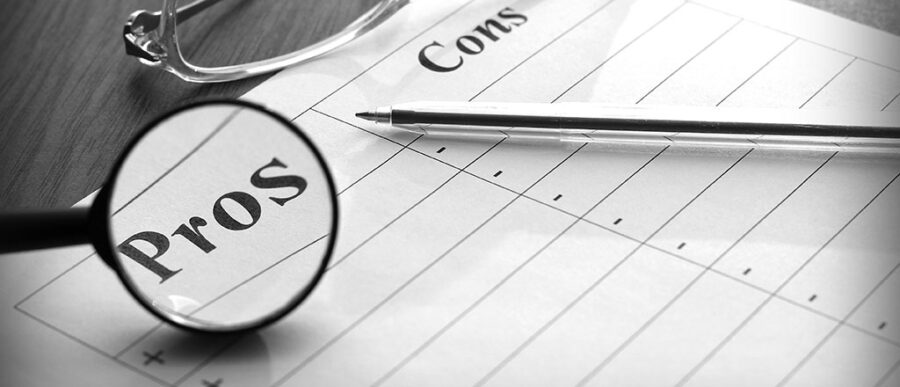Human beings are tasked with making hundreds of choices and decisions daily. Some are relatively simple — Do I want soup or salad for lunch? Should I wear the white shirt or the blue one? But others are so fraught with complications that decision-making can draw out for many restless days and nights.
Rom Y. Schrift, a marketing professor at Wharton, studied the complexities of decision-making in his latest research, “Pain and Preferences: Observed Decisional Conflict and the Convergence of Preferences.” The paper was co-authored with Moty Amar, a professor at Ono Academic College in Israel, and recently published in the Journal of Consumer Research. The results are a revealing look at how the pain of others struggling with the agony of decision-making can influence our own process. The more empathetic a person is, the more likely they will identify with the conflicted decision-maker and select a similar choice. The study yields important information about human behavior that can be used across a broad spectrum of disciplines.
An edited transcript of the conversation appears below.
Making Choices
When we think about the many decisions that we make throughout our lives, often a central component of the decision-making process is the emotional conflict that we experience while making the choice. There are a lot of different symptoms for emotional conflicts like increased heart rate, body language, facial expressions and so on. These are observables, so it’s very easy for us to spot others — it could be strangers at a store, family members, managers — who are experiencing a certain amount of choice conflict.
“Our immediate, instinctive reaction toward someone else’s pain and agony over a decision is to empathize with this individual. We’ll start taking this person’s perspective, sharing his emotional states, which leads to what is called greater connectedness or emerging.”
The question we ask in this research is a very straightforward yet important and understudied question: How does observing someone else going through emotional conflict while making a decision impact our own preferences? Will we be more or less likely to choose a similar option chosen by a conflicted versus a non-conflicted person? What we found is that when I observe someone else going through this emotional conflict and choice, I’ll be more likely to choose a similar option. Why? We find that our immediate, instinctive reaction toward someone else’s pain and agony over a decision is to empathize with this individual. We’ll start taking this person’s perspective, sharing his emotional states, which leads to what is called greater connectedness or emerging. In a sense, I’ll start seeing this person in a more self-like manner, which will essentially lead me to choose a similar option.
The Power of Empathy
What’s interesting is that we find that this tendency is much stronger for people who have a greater innate tendency to empathize with others. In one study, for example, people observed someone making a certain decision about which of two charities to donate money to. What they didn’t know was that this person was a paid actor. One time this person acted as if the decision was extremely conflicting and difficult, and in another condition, [the person acted like] it wasn’t very difficult. We found that when people observed this conflicted actor, they were much more likely to donate to the charity chosen by this conflicted person.
I think there are several intriguing results. The first one is that this response to emotional conflict experienced by others is extremely innate, spontaneous. It will happen even if we observe a complete stranger that we do not know. Another interesting finding is that this happens also when we know that the choice made by this person is completely random. Imagine I’m playing a certain game, and you observe me and the game is pretty simple. I have two doors. Behind one door, there’s a huge monetary reward — let’s say $1 million. Behind another door, there’s nothing. I need to open one of the doors, and whatever is behind this door I get to keep. I’ll be conflicted. I have a chance here to win $1 million, and I don’t know what to do. I’ll probably think about it, and you’ll see this conflict. Now, this conflict that you observe would not inform you about how thoughtful I am. There is no right decision. It’s a completely random decision, yet we find that even in situations where you know it’s completely random, you’ll be more likely to choose the same door that I chose when I experienced conflict in choice.
“We find that pain and conflict bring us closer.”
The third intriguing result is that this effect will happen only if you believe that the conflict that I experience and exhibit is warranted to the decision at hand. If you see me conflicted about something you think is trivial, the effect would completely go away and sometimes even reverse. Going back to the doors example, let’s say that behind one door there’s $1 million, but now behind the second door there’s $900,000. No matter what I choose, I’m going to make a lot of money. If you see me conflicted about this decision, you’ll actually gravitate away from it.
When Conflicts Converge
We find that pain and conflict bring us closer. Think about many situations where there are certain group dynamics — voting or jury duty, for example — where one wishes to form or build a certain consensus around a certain decision he or she is about to make or has already made. The common wisdom will be to be decisive, right? As a manager or a politician, I need to show decisiveness. This research suggests that in some situations, sharing the emotional conflict that you’re experiencing while making a certain decision would actually be very helpful to build consensus as group members or the team that I’m leading would have a greater tendency to choose like I did.
In one study, we asked group members to cast a vote about a certain decision, a real decision that involved monetary outcomes. What we found is that the voting of the group converged to the voting of the first group member if this person showed conflict while making the choice. So, we see a very interesting group dynamic where one person is very conflicted and how others in the group would converge to the same choice.
I think this research suggests that when we think about social influence — how other people’s behaviors and choices impact our own — our preferences are shaped not only by the ultimate choice that others are making, but also by the process leading to this choice. If I see an emotional conflict, then I’ll converge more.
“This research suggests that in some situations, sharing the emotional conflict that you’re experiencing while making a certain decision would actually be very helpful to build consensus.”
What’s Next
The next steps in terms of this research is to look at other decision cues, other things that happened during the decisional process that might influence the observer’s preferences. We’ve also started looking at how process cues such as conflict would impact not only my preferences but also my own decision process. Will I be more likely to be conflicted when I see others conflicted, or less likely? The third kind of investigation that we’re looking at as research from the opposite side is how it makes us feel when someone else sees that we’re experiencing conflict in choice.



